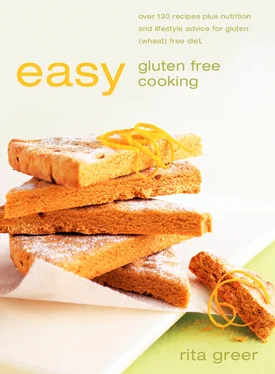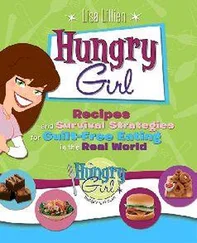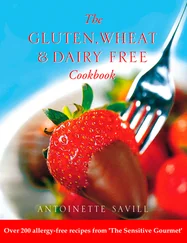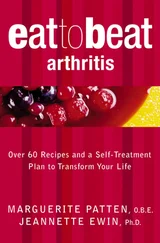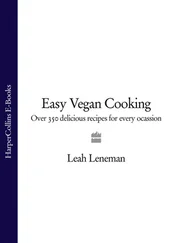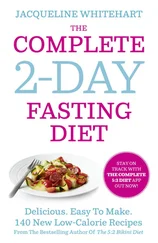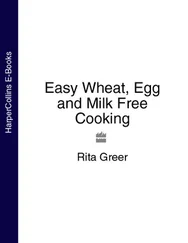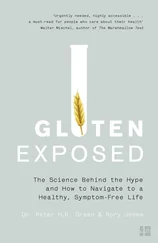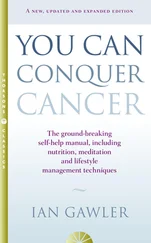over 130 recipes plus nutrition and lifestyle advice
Easy Gluten-Free Cooking
Rita Greer

Cover
Title Page over 130 recipes plus nutrition and lifestyle advice Easy Gluten-Free Cooking Rita Greer
1 chapter one who needs a gluten-free diet? There are two kinds of people who need to be on a gluten-free diet. One is the coeliac (celiac) and the other is the gluten allergic. The two are completely different conditions although they are often confused with one another.
Who Needs a Gluten-free Diet? chapter one who needs a gluten-free diet? There are two kinds of people who need to be on a gluten-free diet. One is the coeliac (celiac) and the other is the gluten allergic. The two are completely different conditions although they are often confused with one another.
2
Cooking for a Gluten-free Diet
3
The Kitchen Cupboard
4
Gluten-free in a Hurry
5
Staple Gluten-free Substitutes
6
Breakfasts
7
Snacks
8
Soups and Starters
9
Main Meals
10 Puddings
11 Tea Time
12 Celebration Food
13 Gluten-free for Children
14 Coping Generally
Index
By the Same Author
Copyright
About the Publisher
chapter one who needs a gluten-free diet? 1 chapter one who needs a gluten-free diet? There are two kinds of people who need to be on a gluten-free diet. One is the coeliac (celiac) and the other is the gluten allergic. The two are completely different conditions although they are often confused with one another. Who Needs a Gluten-free Diet? chapter one who needs a gluten-free diet? There are two kinds of people who need to be on a gluten-free diet. One is the coeliac (celiac) and the other is the gluten allergic. The two are completely different conditions although they are often confused with one another. 2 Cooking for a Gluten-free Diet 3 The Kitchen Cupboard 4 Gluten-free in a Hurry 5 Staple Gluten-free Substitutes 6 Breakfasts 7 Snacks 8 Soups and Starters 9 Main Meals 10 Puddings 11 Tea Time 12 Celebration Food 13 Gluten-free for Children 14 Coping Generally Index By the Same Author Copyright About the Publisher
There are two kinds of people who need to be on a gluten-free diet. One is the coeliac (celiac) and the other is the gluten allergic. The two are completely different conditions although they are often confused with one another.
Up to the middle of the 20th century, the coeliac condition could prove fatal as a gluten-free diet was not used and medicine, drugs or surgery were not the answer. However, it was discovered that a gluten-free diet could control the illness, and today the outlook for the coeliac is good, providing the gluten-free diet is strictly adhered to. Any lapses, however small, can result in a setback with return of symptoms. The diet is for life in more ways than one.
In coeliacs, the small intestine is affected. This is situated between the stomach area and the large intestine, in the lower part of the abdomen. By the time food reaches the small intestine, half way down the food canal, it is ready to be absorbed into the bloodstream. Any waste food is sent on down to the large intestine. The small intestine has a special lining of little fronds (villi). Each frond is covered in tiny ‘hairs’ (the brush border). As the food, already processed, passes down the small intestine, the villi and the brush border absorb the nutrients from the food. Unfortunately, in coeliacs, gluten in the food causes the villi to shrink and become quite flattened. The food passes through and fails to be absorbed. This causes unpleasant symptoms and the coeliac becomes malnourished. The patient looks and feels completely ‘washed out’ – not surprising in the circumstances.
Changes in small intestine in the coeliac (celiac) condition.
Normal
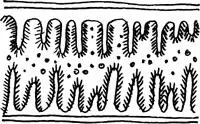
Villi with brush border and particles of food for absorption and digestion.
Abnormal
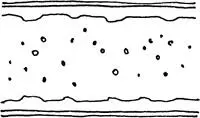
Villi flattened so particles of food cannot be absorbed and digested.
The coeliac condition is a puzzling one to diagnose as the patient seems to eat well but not to thrive. In the case of the coeliac child, there can be failure to grow, and the more the child eats the worse the condition becomes as more gluten is consumed. But there is good news: without gluten in the diet, the damaged lining of the small intestine is able to grow back the villi and brush border. Once the function is restored, health and vitality can be regained and children can grow again.
Some coeliacs with less severe symptoms can remain undiagnosed for years and continually suffer and recover. Common diagnoses for this are a ‘digestive disorder’, irritable bowel syndrome (IBS), allergy or, worse still, ‘imagination’. When eventually diagnosed, it is sometimes called ‘silent coeliac disease’.
The symptoms for food allergy/intolerance/sensitivity are many and varied. They have little or no connection with the coeliac (celiac) condition. An allergy, intolerance or sensitivity to gluten may manifest itself in one or more symptoms. It is difficult to be specific about what is causing the symptoms as they can also be caused by other factors. There is now a detection kit available from pharmacies. Consult the qualified pharmacist for advice. People with persistent symptoms should consult their medical practitioner and not try to diagnose and treat themselves.
Feeling dizzy or faint, headaches, migraine, heavy feeling.
Watery, itchy, red, swollen, tired, sore, blurred vision, heavy feeling in eyelids.
Runny nose, sneezing, itching, burning, excessive mucus, blocked nose, sinusitis.
Ringing in the ears, soreness, loss of hearing, earache, burning sensations, itching.
Soreness, sore gums, swollen tongue, mouth ulcers, loss of taste, hoarseness, cough, choking fits, itching of the roof of the mouth, bad breath.
Chest pains, palpitations, rapid heartbeat, asthma, chest congestion, tightness across chest, shallow breathing, excessive sighing, breathlessness, catarrh.
Nausea, vomiting, stomach cramps, diarrhoea, constipation, swollen stomach, bloated feeling after eating, flatulence, feeling ‘full up’ long after meals, stomach pains, poor appetite, cravings for foods, dyspepsia.
Rashes, hives, inexplicable bruises, easily marked skin, eczema, excessively pale colour, dermatitis, itching, soreness, redness, sores, acne.
Weakness, cramp, cold hands and feet, flushing, shivering fits, trembling, aches and pains in the joints, swelling of the limbs, aches and pains in the muscles, swelling of the face, hands, feet, ankles, constant feeling of hunger, gorging with food, oedema, obesity.
Читать дальше
